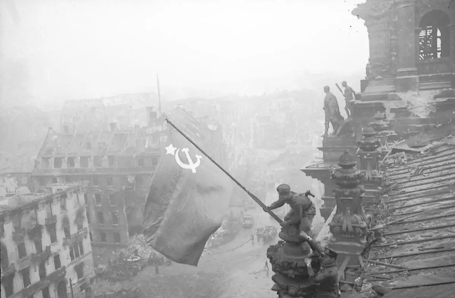(Original photo. Photo from this website.)
This is one of the most infamous photos from World War II. It’s two Soviet soldiers hoisting a flag over the bombed-out remains of the Reichstag. It was revelaed later that not only was the photo staged, but apparently both soldiers in the photos had wristwatches covering their arms, likely looted from German civilians on their way to the Reichstag. Those watches were worth a lot of money, but to sidestep Stalin’s anger, the photographer doctored the photos so the stolen watches weren’t visible. The photographer, Yevgeny Khaldei, knew evidence of Soviet looting would not go over well with the man in charge, so he took care of the issue.
While he was removing the wristwatches (which you can see if you look closely at the photo above, but I will show in detail in a moment), he darkened the smoke, made the whole scene a bit more dramatic, and a bit moodier.
(Doctored photo. Photo from this website.)
Photo editing in the USSR didn't start with this photographer. Rather, he was following a storied history since Stalin came to power in 1929. While occasionally I see people on social media pass around obviously edited photos of Stalin with those around him carefully disappearing in each shot, it's never taken too seriously. Back in Stalin's day, however, it was cutting edge. This was an important cog in the propaganda wheel, as it were. This manipulation and editing of not only himself, but the people around him and even situations like the one pictured above was one of the ways Stalin kept his thumb on what the Soviet people, as well as the wider world.
Keep in mind, there was no photoshop back then, so this manipulation took very real effort and careful thought on the parts of those doing the doctoring. It wasn't some vanity project, but rather something that people did with a purpose, and, as you'll see, over time, it became something many people in the USSR did voluntarily. Afraid of what would happen if they were caught with a photo of a person who was out of favor in their house, be it in a magazine or a newspaper or any other means, may Soviet citizens began scratching out images they might find in their own house, in their own magazines, on their own time in an effort to not fall out of favor, or get in trouble.
So how did they do this? Apparently it was a job for the art department of publishing houses at the time, and it was all hands-on work that required a lot of attention to detail and dexterity. Commonly used tools were a scalpel, glue, and an air brush. Publishers would be contacted by individuals who worked for Stalin, and informed about who was the enemy of the week. Then, the art department would go to work at getting rid of that person in all the photos and publication they had.
Nikolai Yezhov was the man who oversaw Stalin's Great Purge in 1937-38. When he was ousted by Lavrenty Beria, Yezhov was arrested, tried as an enemy of the people in a secret court, where he duly confessed to a laundry list of crimes that would make him just that. He was executed in February of 1940. Soon thereafter, he was erased from public memory.
Stalin didn't just deal with current day issues, though. He often went back and carefully edited history as well.
Leon Trotsky and Stalin had a long running feud. After Trotsky was ousted from the Soviet Union and went abroad, Stalin had all the photos with Trotsky in them altered to remove the man.
He even went so far as to have some of the historical record prettied up a bit. Made a little more dramatic. For example:
(Image of a demonstration during the 1917 revolution. In the first photo, the flag is unreadable and the sign is for a clock shop. In the second, the sign says, "You'll take what's yours through struggle" and the flag says, "Down with the monarchy!" From this website.)
And it went as far as Stalin's public image as well. His portrait was everywhere, but he was very picky about how he wanted to be portrayed. Stalin suffered from smallpox as a child, and had scars all over his face. However, in most images you see of him, his scars have been airbrushed out, his hair has been smoothed, and his attraction level has generally been increased.










Comments
Post a Comment